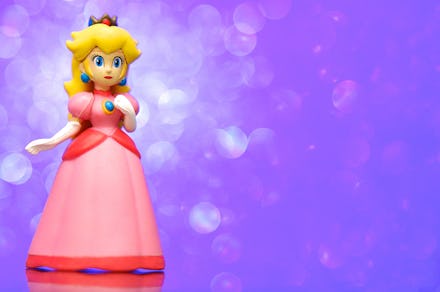5 Charts That Show Sexism Is Still Alive and Well in Gaming

In August, feminist critic and commentator Anita Sarkeesian was forced from her home after anonymous Internet trolls lobbed a series of violent and misogynistic threats her way. That same month, Zoe Quinn, a video game developer, left her home and began couch surfing after she was hit with a tsunami of similar harassment from people who obtained her contact information. Then, in October, video game developer Brianna Wu and her husband fled their home after Brianna received death threats from, among other sources, a Twitter account called "Death to Brianna."
Their crimes? Being women who participated in something they loved — the gaming community.
Adult women are now the biggest demographic in gaming — a group far larger than teenage boys. But the industry hasn't done much to make its many new users feel welcome. The existence of misogyny in spaces that have traditionally catered to men isn't new or surprising, but the insistence that it doesn't exist is particularly vociferous in gaming. The recent #Gamergate movement, for example — the same campaign that targeted Sarkeesian, Quinn and Wu — attempted to disguise its anti-feminist campaigning with a veneer of seeking "ethics in gaming journalism."
But sexism is a very tangible and ongoing reality in the gaming community. If bits and pieces of anecdotal evidence — vile comments directed at female gamers, sexual harassment at gaming conventions, the overt objectification of female video game characters, harassment at the hands of coaches, personal stories from women themselves — isn't enough, take a glance at the following numbers.
1. Female protagonists are still underrepresented.
Anita Sarkeesian and her team at Feminist Frequency attended this year's Electronic Entertainment Expo, a trade fair at which top industry members can preview the games and merchandise game publishers have in store for the year.
After calculating the gender breakdowns for 76 upcoming games from the likes of Bethesda Softworks, Microsoft Studios, Sony Computer Entertainment, Electronic Arts, Ubisoft, Nintendo and Square Enix, Feminist Frequency found that there were seven games with "exclusively playable female protagonists," or 9% of the titles. Twenty-four games, or 32%, had "exclusively playable male protagonists."
While there were 35 games that included a choice between male and female protagonists, Feminist Frequency notes that only one of those games, Dishonored 2, marketed itself at E3 using primarily the female character.
"As long as games continue to give us significantly more stories centered on men than on women, they will continue to reinforce the idea that female experiences are secondary to male ones," the site concludes.
2. Zero out of eight of the biggest game publishers are helmed by women.
Eight of the world's largest video game publishers — Nintendo, Ubisoft, EA, Sony, Square Enix, Microsoft, Bandai Namco Games and Activision Blizzard — all have a man in their highest-ranking leadership position.
More worryingly, as Forbes pointed out in September, "While more women are playing video games, their ranks aren't growing as quickly in positions of power in the video game business." Despite their share of the video-gaming audience, the number of men in leadership roles continues to dwarf the number of women.
3. The #Gamergate movement, which purported to focus on gaming journalism, spent a sizable amount of its time harassing women gamers.
Newsweek's Taylor Wofford examined the quantity and tenor of tweets directed at various people involved in the #Gamergate controversy, and found that, contrary to its stated goals, much of the attention was directed at three non-journalist women in gaming: Anita Sarkeesian, Brianna Wu and Zoe Quinn.
Conversely, a gaming journalist, Nathan Grayson, who was accused of sleeping with Quinn and later favorably reviewing her work — received next to nothing compared to the three women. Grayson's editor, Stephen Totilo, received a similarly low number of tweets.
"Tweets directed at Grayson and Totilo were, on average, more negative than those directed at Quinn, Wu or Sarkeesian," Wofford wrote. "But Quinn, Wu and Sarkeesian were on the receiving end of more negative tweets overall than Grayson, Totilo and Kotaku [a gaming website]," suggesting that Gamergaters put a good deal of their energy into harassing female members of the community.
4. Online gaming communities continue to be more hospitable for men.
The Pew Research Center's October report on online harassment found that while the overall landscape for women on the Internet wasn't overly positive, the realm of online gaming was particularly bad.
When respondents were asked what environments they believed were most welcoming to men and women, the results were telling. "While most online environments were viewed as equally welcoming to both genders, the starkest results were for online gaming," the report said. "Some 44% of respondents felt the platform was more welcoming toward men."
Then again, given the abuse women gamers are routinely subjected to online, the numbers are hardly shocking.
5. Men dominate the ranks of game developers.
Women developers have made inroads recently, but they're not all the way there yet — not even close.
According to the International Game Developers Association, a global professional association with more than 12,000 members, of the more than 2,200 developers surveyed, only 22% are women. That percentage has almost doubled since 2009, when the last survey was released, but 22% is still an abysmally low figure, particularly when one considers that women make up an increasingly large proportion of the gaming audience.
A lack of female representation among developers carries many of the same problems as a workplace lacking diversity. With a dearth of different perspectives, the voices and stories of a certain few — in this case, white men — are expressed more strongly and consistently. But the gaming community has far more nuance and variance than this, which can often get lost when there's no one like that making the games themselves.